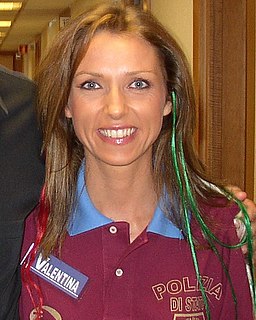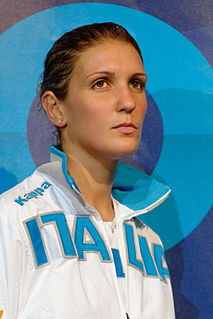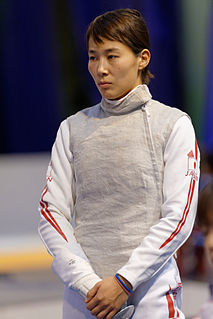
Women's fencing is the practice of fencing by women. It has been present at the Summer Olympic Games since the 1924 Olympics in Paris. Foil was then the only weapon used and Danish Ellen Osiier became the first female Olympic champion in fencing.

Women's fencing is the practice of fencing by women. It has been present at the Summer Olympic Games since the 1924 Olympics in Paris. Foil was then the only weapon used and Danish Ellen Osiier became the first female Olympic champion in fencing.

| Wikimedia Commons has media related to Women's fencing . |
| This fencing-related article is a stub. You can help Wikipedia by expanding it. |

Fencing is a group of three related combat sports. The three disciplines in modern fencing are the foil, the épée, and the sabre ; winning points are made through the weapon's contact with an opponent. A fourth discipline, singlestick, appeared in the 1904 Olympics but was dropped after that, and is not a part of modern fencing. Fencing was one of the first sports to be played in the Olympics. Based on the traditional skills of swordsmanship, the modern sport arose at the end of the 19th century, with the Italian school having modified the historical European martial art of classical fencing, and the French school later refining the Italian system. There are three forms of modern fencing, each of which uses a different kind of weapon and has different rules; thus the sport itself is divided into three competitive scenes: foil, épée, and sabre. Most competitive fencers choose to specialize in one weapon only.
At the 2000 Summer Olympics, ten fencing events were contested. Men competed in both individual and team events for each of the three weapon types. Women competed in the foil and the épée events. The events took place at the Sydney Convention and Exhibition Centre.

A foil is one of the three weapons used in the sport of fencing, all of which are metal. It is flexible, rectangular in cross section, and weighs under a pound. As with the épée, points are only scored by contact with the tip, which, in electrically scored tournaments, is capped with a spring-loaded button to signal a touch. A foil fencer's uniform features the lamé. The foil is the most commonly used weapon in competition.

The épée is the largest and heaviest of the three weapons used in the sport of fencing. The modern épée derives from the 19th-century Épée de Combat, a weapon which itself derives from the French small sword.
Classical fencing is the style of fencing as it existed during the 19th and early 20th century. According to the 19th-century fencing master Louis Rondelle,
A classical fencer is supposed to be one who observes a fine position, whose attacks are fully developed, whose hits are marvelously accurate, his parries firm and his ripostes executed with precision. One must not forget that this regularity is not possible unless the adversary is a party to it. It is a conventional bout, which consists of parries, attacks, and returns, all rhyming together.

Valentina Vezzali is an Italian fencer and politician. As fencer she has won six Olympic gold medals in foil competitions.
The Amateur Fencers League of America (AFLA) was founded on April 22, 1891, in New York City by a group of fencers seeking independence from the Amateur Athletic Union. As early as 1940, the AFLA was recognized by the Fédération Internationale d'Escrime (FIE) and the United States Olympic Committee as the national governing body for fencing in the United States.
Margherita Granbassi is an Italian foil fencer.

Giovanna Trillini is an Italian foil fencer. She is a 4-time Olympic champion and she won an additional silver and two bronze medals in individual Olympic competitions.

Aida Mohamed is a Hungarian foil fencer, silver medallist at the 1993 World Championships and team gold medallist at the 2007 European Championships. She has competed at six Olympic Games from 1996 to 2016.
Ellen Osiier was a Danish foil fencer.

Laura Gabriela Badea-Cârlescu is a retired Romanian foil fencer, world champion in 1995 and Olympic champion in 1996. After her retirement she became a coach, then a sport administrator. She is now vice-president of the Romanian Fencing Federation and a member of the Romanian Olympic and Sports Committee.

Fencing competitions at the 2010 Summer Youth Olympics in Singapore consisted of three Cadet Male individual events, three Cadet Female individual events and one team event including both genders and all 3 weapons: épée, foil and saber. 78 fencers from 36 nations were competing. The venue was located at the International Convention Centre (ICC).

Arianna Errigo is an Italian foil and sabre fencer. She won a silver in women's individual foil and a gold in the women's team foil at the 2012 Summer Olympics.
Elaine Gayle Cheris is an American Olympic fencer.

The Italian Fencing Federation is the national governing body for the fencing sport in Italy. The FIS is currently based in Rome. The FIS was founded is 1909 and was one of the nine founding nations of The Fédération Internationale d'Escrime (FIE) in 1913. The FIS has in total achieved 219 metals at Euro Championships, 319 medals at the World Championships and 123 Olympic medals. FIS is funded mainly by sponsors among which are Kinder.

Shiho Nishioka is a Japanese female foil fencer.

Annalisa Coltorti is an Italian épée fencer.
Marcello Lodetti graduated in 1959 from the Accademia Nazionale Magistrale (ANS) and started fencing at the age of 7 at the Mangiarotti fencing club in Milano, near the Giuseppe Verdi conservatory. He then became a pupil of Giuseppe Mangiarotti, who had himself been a pupil of Renaud.